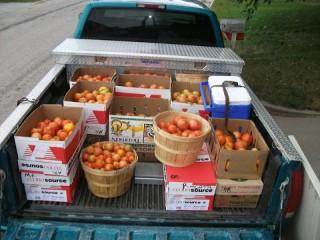I have been working for about 7 years at converting all of my crops to locally-adapted landraces. I'm currently growing about 70 landrace varieties for about 55 species. Some are more locally-adapted than others. Some are still very tentative: Maybe producing more seed than went into the ground on a good year... Others are well adapted and perfectly suited to my taste preferences, and way of doing things, and the local environment. I think that this is the third year that I have grown just about all of my own seed. I start out by calling a mix of varieties a grex, or a mass cross. After a few years I'll start calling them a proto-landrace. Then, when they get really well adapted to my garden, and have a lot of genetic diversity going on I'll call them a landrace. They gotta be closely aligned to local conditions, and to the farmer's way of doing things before I call them a landrace.
About 60 varieties of muskmelons may have contributed genes to my muskmelon landrace. Only about 3 plants grew well the first few years. They went on to form the foundation of my landrace muskmelons.
I trialed about 80 varieties of beans, only about 20 of them survived the first growing season, but they hybridized and I trialed more, so my bean landrace currently contains about 100 varieties: All of them do well to really well here.
Many hundreds of varieties may have contributed to my corn and watermelon landraces. I really like the yellow-fleshed melons, and expect to transition to a mostly yellow population.
About 6 varieties of spinach contributed to that landrace. Around 12 varieties were trialed, but half of them were totally unacceptable. I ate my spinach landrace for lunch today... Mmm. Mmmm. Mmmmm. After I fed my sister's family spinach that was full of worms that were hiding inside wrinkled leaves, I started chopping out all wrinkly-leaved spinach plants before letting the rest go to seed. Last time I trialed a commercial variety of spinach it got about an inch tall before it bolted.
I'm not keeping any varieties pure and true to type, but I am keeping the genes around for many thousands of varieties.
Tomatoes are a crop that tends to do very poorly for me. When I trial tomatoes from far away, I get about 90% failure rates. People really want tomatoes, so I'm working on converting my tomatoes to a promiscuously pollinating population so that I can play the genetic lottery more frequently and with less effort. I expect that they will also end up being yellow-fruited, because I really don't like the taste of lycopene which makes watermelons and tomatoes red. That will be the hyper-local adaptation to the farmer's taste preference. Because even though my market wants red tomatoes, eventually I will grow mostly yellows because they are not so gaggy tasting to the farmer.
An early proto-landrace of tomatoes.

 8
8




 2
2




 3
3





















 1
1















